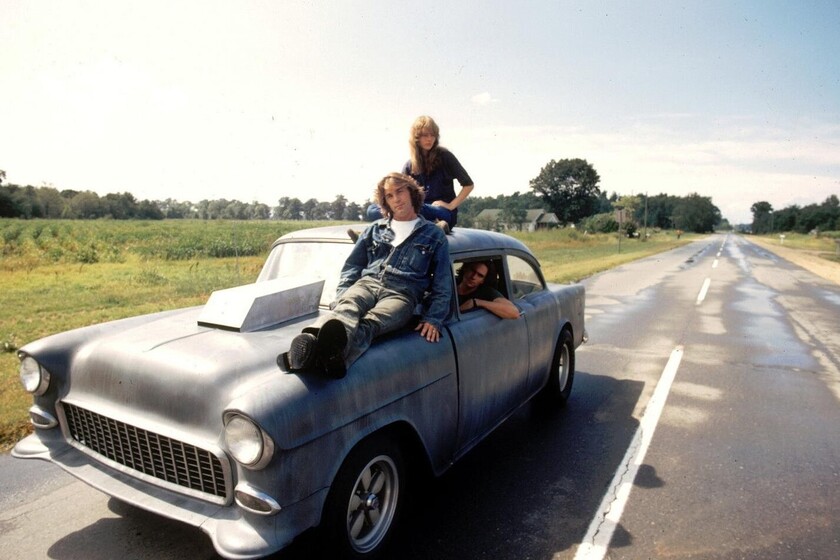April 20, 2021 marks the death of Monte Hellman at 91, one of those race filmmakers that Quentin Tarantino adored, and not only for being the executive producer of ‘Reservoir Dogs’ (1992). His death, in Palm Desert (California), after a fall at his home, is another symbolic echo of the change in the way of making films in Hollywood, in times of platforms and ‘Asphalt road in two directions‘(Two-Lane Blacktop, 1971) is a living testimony to that forgotten era.
Among his classics we also find ‘El tiroteo’ (The Shooting, 1966) or ‘Game-cock‘(Cockfighter, 1974), almost a spiritual epilogue of’ Carretera ‘, the ones that preserve the greatest trace of an author who He always moved skillfully between very fair budgets, as a lesson from having passed through the Roger Corman factory, something in common with so many other creators of American independent cinema. Representing a freedom and spirit that permeates the song at twilight of ” Once upon a time in Hollywood ” (2019), whose characters could enter and leave a Hellman movie, just like Stuntman Mike from ‘Death Proof’ (2007)
The philosophy of an entire era
From the Corman factory, his debut came out ‘The beast from the cursed cave‘(1959), a series B that he described as “Cayo Largo with monster”, with which it can also be guessed that the game of genres from the script of’ Open until dawn ‘(1996) also has its dna. Hellman was another of Corman’s pupils, like Francis Ford Coppola, Jack Nicholson, Peter Fonda, Peter Bogdanovich, John Sayles, or Jonathan Demme. With Coppola he collaborated directing the opening sequence of ‘Dementia 13’, but where Hellman found his space was in the portrait of America in the 70s, in which ‘Asphalt road in two directions’ can be seen as the intimate reverse of’ Easy Rider: looking for my destiny ‘(1969).
However, Hellman is more reluctant to the contemporary and maintains a lo-fi spirit that perhaps helped the film remain in oblivion for years, in which it was hardly possible to see it fleetingly in night broadcasts or small projections, which It was gaining a reputation throughout the 70s, 80s and 90s as one of the lost masterpieces of the New Hollywood era. As with the unearthed jewels, the criterion edition of just a few years ago rescued an essential film to show all its virtues and defects, but also how key piece to understand the generational philosophy of a decade.

The story of the film is so simple that its characters are called “the driver” (singer James Taylor) and “the mechanic” (Dennis Wilson, the drummer of The Beach Boys who welcomed the Manson family into his home), two men who they’re not going anywhere as fast as they can, challenging strangers to races until they find “the girl” (Laurie Bird), a hitchhiker with whom the driver falls in love, and an older man, GTO (Warren Oates), who takes its name from the brand of its yellow car, with those who travel the roads in tandem with the heroes.
An abstract road movie
The situation creates a subtle rivalry of egos, like an absurd race in which it does not matter who wins since the three men are lost and the woman is a non-apparent trophy that indicates the masculine character of the piece, and can be read as a trip to nowhere from the very masculinity that his big cars emanate and how its protagonists play to see which of them is more laconic. ‘Asphalt road in two directions’ is a rarity, starting with the protagonism of two musicians in their only acting roles.

The lack of dialogue leads to an abstract experience, which under your movie textures grindhouse hides a spirit of art and essay in which his characters merge with his 55 Chevy and the road, where the men who don’t have to speak to prove their worth and from whom Hellman extracts naturalism from asphalt by placing them on back roads in the United States, in unglamorous races and many spaces where the silence of driving becomes as everyday as it is strangely poetic. , where sentimental frustration does not necessarily lead to any tragedy.
The goals of its protagonists are mere vanishing points, since the truth that their interactions really hide hide an addiction to the freedom of the road, in which, as the title evokes, the important thing is not to run away from something or run towards something , but the feeling of being uprooted for good or bad, we cannot discern if its characters seek to lose themselves or redeem themselves, perhaps for this reason its end is abrupt and different from what is expected, with an unprecedented, avant-garde and meta trick in which celluloid burns, implying that the important thing has happened a few minutes before, which evokes the idea of letting expectations and ties fly.

Hellman’s panoramic offers a sophisticated look at the American male obsession, which look from a counterculture perspective, with a journey that reflects the feeling of drift of a youth opposed to the values of their parents, a drawing of lives aimlessly that often also loses its way, perhaps what differentiates it from the much more vitalistic, round and epic ‘Limit point: Zero’ (Vanishing Point, 1971), is that it is so free that it is not he worries about granting absolutely nothing to the viewer, but telling a feeling from the margins, only with images, before which one can only appreciate a tangible and lost cinema that still retained the quality of being able to burst into flames.

